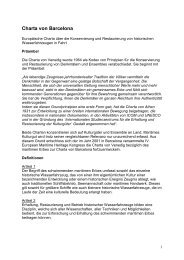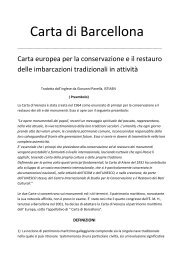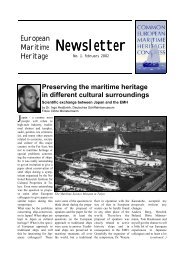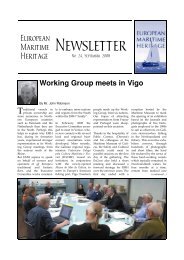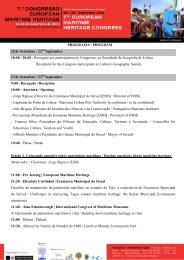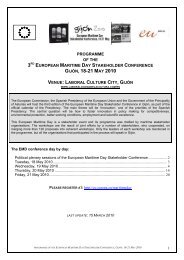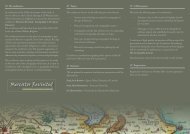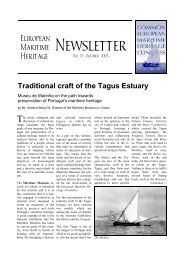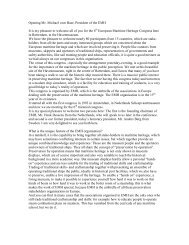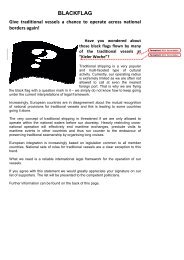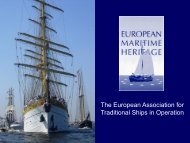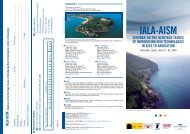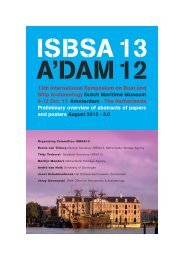Memorandum of Understanding - European Maritime Heritage EMH
Memorandum of Understanding - European Maritime Heritage EMH
Memorandum of Understanding - European Maritime Heritage EMH
You also want an ePaper? Increase the reach of your titles
YUMPU automatically turns print PDFs into web optimized ePapers that Google loves.
<strong>Memorandum</strong> <strong>of</strong> <strong>Understanding</strong><br />
on the mutual recognition <strong>of</strong> certificates for the safe operation<br />
<strong>of</strong> traditional ships in <strong>European</strong> waters and<br />
<strong>of</strong> certificates <strong>of</strong> competency for crews on traditional ships<br />
28 th November 2005
The <strong>Maritime</strong> Authorities <strong>of</strong><br />
Denmark<br />
Estonia<br />
Finland<br />
Germany<br />
The Netherlands<br />
Norway<br />
Spain<br />
Sweden<br />
the United Kingdom<br />
hereinafter referred to as "the Authorities"–<br />
(1) noting that during the past few decades an increasing public interest in<br />
keeping historically valuable ships alive has led to a range <strong>of</strong> activities in the field <strong>of</strong><br />
maritime heritage aiming at the preservation <strong>of</strong> such ships in active use, usually for<br />
private, social or cultural purposes but also as a commercial venture;<br />
(2) noting further that the variety <strong>of</strong> types <strong>of</strong> vessels developed under different<br />
influences <strong>of</strong> geography, culture and economy ranges from primarily sailing vessels<br />
with an auxiliary engine to power-driven vessels, many <strong>of</strong> them with steam<br />
propulsion, former fishing boats and cargo vessels as well as coastal passenger<br />
traditional ships, tugs, icebreakers, light vessels and others. Many <strong>of</strong> them are<br />
preserved, having been well maintained in public service. Figures available indicate<br />
that around 5,000 sea-going ships <strong>of</strong> historical interest and regional character have<br />
survived until now in Europe. An overwhelming majority <strong>of</strong> them have proved to be<br />
safe and seaworthy when properly maintained, equipped and operated by<br />
experienced crews;<br />
(3) noting also that, in several countries in Northern and Western Europe,<br />
Governments have adopted standards for traditional ships with different approaches<br />
concerning the standards applicable to the construction and equipment as well as the<br />
28 th November 2005
2<br />
safe operation and the certification <strong>of</strong> crews for such ships, which causes problems<br />
during port state control;<br />
(4) noting with appreciation the progress achieved in this field by the Common<br />
<strong>European</strong> <strong>Maritime</strong> <strong>Heritage</strong> Congress (C<strong>EMH</strong>C);<br />
(5) recognizing that the preservation <strong>of</strong> historically valuable ships in their traditional<br />
condition and their operation as a common living maritime heritage is <strong>of</strong> public<br />
interest;<br />
(6) stating that a possible lack <strong>of</strong> modern technology on traditional ships<br />
should be compensated for by operational measures to provide an equivalent level <strong>of</strong><br />
safety without destroying the historical character <strong>of</strong> the ships;<br />
(7) recognizing the need to have special minimum standards different from<br />
regulations governing commercial ships, which will enable the traditional ships to<br />
comply with a level <strong>of</strong> safety that is equivalent to the safety level <strong>of</strong> modern ships<br />
subject to generally accepted international conventions, regulations, procedures and<br />
practices as well as to national law and, as far as traditional ships flying a flag <strong>of</strong> a<br />
Member State <strong>of</strong> the <strong>European</strong> Union are concerned, to binding provisions based on<br />
the EC Treaty such as Directive 98/18/EC, as amended;<br />
(8) recognizing also that where IMO Conventions are applicable to all ships,<br />
for instance with respect to environmental issues, traditional ships have to comply<br />
with these regulations and therefore the subject will not be dealt with in this <strong>Memorandum</strong>;<br />
(9) recognizing further, that a traditional ship as such should be used to<br />
promote traditional skills, seamanship and awareness <strong>of</strong> the maritime heritage; not to<br />
be engaged in transport an a pr<strong>of</strong>it base beyond the costs <strong>of</strong> operation and<br />
maintenance.<br />
28th November 2005
3<br />
(10) convinced <strong>of</strong> the necessity, for these purposes, <strong>of</strong> mutual recognition <strong>of</strong><br />
national certificates for the safe operation <strong>of</strong> traditional ships in <strong>European</strong> waters and<br />
<strong>of</strong> certificates <strong>of</strong> competency <strong>of</strong> crews on such traditional ships on the basis <strong>of</strong> a<br />
minimum standard adopted by the Common <strong>European</strong> <strong>Maritime</strong> <strong>Heritage</strong> Congress<br />
(C<strong>EMH</strong>C) as well as <strong>of</strong> national safety certificates for traditional ships concerning<br />
construction, equipment and radio requirements;<br />
(11) convinced further that minimum safety standards for traditional ships<br />
would enhance the safety and the unhindered navigation and strengthen the cooperation<br />
and exchange <strong>of</strong> information among owners <strong>of</strong> such ships and the<br />
Authorities -<br />
have reached the following understanding:<br />
Section 1 - Compliance<br />
1.1 Each Authority is prepared to comply with the guidelines provided for by the<br />
present <strong>Memorandum</strong>.<br />
1.2 Each Authority confirms that a Document <strong>of</strong> Compliance shall be issued in the<br />
format listed in Annex I. The Document <strong>of</strong> Compliance confirms that the ship<br />
complies with the requirements <strong>of</strong> it’s national legislation for the operation <strong>of</strong><br />
traditional ships flying the flag <strong>of</strong> the state <strong>of</strong> that Authority and meet the<br />
guidelines provided for by the present <strong>Memorandum</strong> and it’s Annex I.<br />
Each Authority is willing to recognize<br />
– The Document <strong>of</strong> Compliance for ships classed as Traditional Ships;<br />
– national certificates <strong>of</strong> competency <strong>of</strong> crews <strong>of</strong> traditional ships<br />
under the flag <strong>of</strong> a state whose Authority is a signatory to this <strong>Memorandum</strong>,<br />
when calling at a port or participating in races, parades and festivals in its<br />
waters, provided that the certificates for safety, the safe operation and the<br />
competency <strong>of</strong> crews are issued under the guidelines <strong>of</strong> the present<br />
<strong>Memorandum</strong> and it’s Annex I thereto as guidance to minimum standards<br />
subject to the amendment procedure in section 3.3 and to the generally<br />
28th November 2005
4<br />
accepted international conventions, regulations, procedures and practices as<br />
well as to national law and, as far as traditional ships flying the flag <strong>of</strong> a<br />
Member State <strong>of</strong> the <strong>European</strong> Union are concerned, to binding provisions<br />
based on the EC Treaty such as Directive 98/18/EC.<br />
1.3 The Authorities might carry out port state control inspections, which would<br />
consist in a visit on board a traditional ship in order to check whether the ship<br />
has valid certificates as referred to in section 1.2 above. Furthermore, the<br />
Authorities might satisfy themselves that the crew and the overall condition <strong>of</strong><br />
the traditional ship including the engine room meets the generally accepted<br />
minimum standards reproduced in Annex II hereto.<br />
In the absence <strong>of</strong> valid certificates, or if there are clear grounds for believing<br />
that the condition <strong>of</strong> a traditional ship or <strong>of</strong> its equipment or its crew does not<br />
substantially meet the requirements <strong>of</strong> the Annexes hereto, the flag state<br />
would be informed.<br />
In the case <strong>of</strong> deficiencies which are clearly and immediately hazardous to<br />
safety, health or the environment, the Authority would ensure, except as<br />
provided for in section 1.4 below, that the hazard is removed before the<br />
traditional ship is allowed to proceed to sea. For this purpose, appropriate<br />
action would be taken, which might include detention or formal prohibition <strong>of</strong> a<br />
traditional ship to continue operating on grounds <strong>of</strong> established deficiencies<br />
which, individually or together, would render the continued operation<br />
hazardous.<br />
1.4 Where deficiencies which have caused a detention as referred to in<br />
section 1.3 above cannot be rectified in the port <strong>of</strong> inspection, the Authority<br />
might allow the traditional ship concerned to proceed to the nearest<br />
appropriate repair yard available as chosen by the master and the Authority,<br />
provided that the conditions determined by the competent authority <strong>of</strong> the flag<br />
state and agreed by the Authority are complied with. Such conditions would be<br />
aimed to ensure that the traditional ship can proceed without risk to the safety<br />
28th November 2005
5<br />
and health <strong>of</strong> the crew or risk to other ships or without being an unreasonable<br />
threat <strong>of</strong> harm to the marine environment.<br />
1.5 In the case <strong>of</strong> a detention, the Authority would immediately notify the flag state<br />
Administration in writing, which includes the report <strong>of</strong> inspection.<br />
Section 2 - Definition<br />
For the purposes <strong>of</strong> the present <strong>Memorandum</strong> <strong>of</strong> <strong>Understanding</strong>, “traditional ships”<br />
can be all kinds <strong>of</strong> historical ships and their replicas including those designed to<br />
encourage and promote traditional skills and seamanship, that together serve as<br />
living cultural monuments, operated according to traditional principles <strong>of</strong> seamanship<br />
and technique, and holding a Document <strong>of</strong> Compliance in the format listed in<br />
Annex I.<br />
Section 3 - Committee<br />
3.1 A committee should be established, which should be composed <strong>of</strong> a<br />
representative <strong>of</strong> each <strong>of</strong> the participating Authorities. In addition, this<br />
committee should include designated representatives <strong>of</strong> the Common<br />
<strong>European</strong> <strong>Maritime</strong> <strong>Heritage</strong> Congress (C<strong>EMH</strong>C) as observer.<br />
3.2 The committee should meet on a regular basis and at such other times as it<br />
may decide under the chairmanship <strong>of</strong> an Authority, which should hand over<br />
the chairmanship to another Authority at the next meeting.<br />
3.3 The committee should<br />
1. promote the unhindered navigation <strong>of</strong> traditional ships and resolve any<br />
major problems which might arise from port state control;<br />
2. develop and review procedures for the exchange <strong>of</strong> information;<br />
28th November 2005
6<br />
3. keep under review the present <strong>Memorandum</strong>, the Annexes thereto and<br />
other matters relating to the operation <strong>of</strong> traditional ships and the<br />
effectiveness <strong>of</strong> the <strong>Memorandum</strong>, for instance the legal status <strong>of</strong><br />
persons on board, i.e. passengers, trainees etc;<br />
4. decide on the application for membership by other interested <strong>Maritime</strong><br />
Authorities;<br />
5. take full account <strong>of</strong> the specialist advice available from the <strong>EMH</strong><br />
representatives in the committee.<br />
Section 4<br />
4.1 The present <strong>Memorandum</strong> is without prejudice to rights and obligations under<br />
any international convention or agreement.<br />
4.2 A <strong>Maritime</strong> Authority <strong>of</strong> a <strong>European</strong> coastal state or <strong>of</strong> a coastal state <strong>of</strong> the<br />
North Atlantic Basin from North America to Europe, which complies with the<br />
standards reproduced at the Annexes hereto, might sign to the present<br />
<strong>Memorandum</strong> <strong>of</strong> <strong>Understanding</strong> with the consent <strong>of</strong> all Authorities which are<br />
already signatories to this <strong>Memorandum</strong>.<br />
4.3 Termination<br />
A signatory might terminate his participation in the present arrangement by<br />
announcing this intention to the other signatories 90 days in advance.<br />
Section 5 - Amendments<br />
5.1 The MoU may be amended at a Committee meeting.<br />
5.2 Each member state or observer organisation may propose amendments to the<br />
MoU. The member states shall agree on amendments by consensus.<br />
28th November 2005
7<br />
5.3 Amendments that have been agreed upon at a committee meeting should<br />
come into force three months after the closure <strong>of</strong> the meeting unless prior to<br />
that date one or more member states have communicated their objection to<br />
the member state having the chair.<br />
5.4 The whole MoU text, including the amendments, should be reproduced when<br />
a new version comes into force. The amended parts <strong>of</strong> the revised version<br />
should be indicated in the margin.<br />
5.5 If there is a need for a prompt change <strong>of</strong> the MoU between two committee<br />
meetings, this can be done by circulating the proposed amendments for<br />
acceptance by all member states. The member state hosting the latest<br />
meeting should be responsible for circulating such amendments. Providing<br />
that there is consensus between the member states the revised MoU enters<br />
into force on the date indicated in the circulated amendments.<br />
Section 6–Prior Agreement<br />
The present <strong>Memorandum</strong> <strong>of</strong> <strong>Understanding</strong> signed in on the<br />
Two Thousand And Five replaces and abrogates the <strong>Memorandum</strong> <strong>of</strong> <strong>Understanding</strong><br />
on the mutual recognition <strong>of</strong> certificates for the safe operation <strong>of</strong> traditional ships in<br />
<strong>European</strong> waters and <strong>of</strong> certificates <strong>of</strong> competency for crews on traditional ships<br />
originally signed in Wilhelmshaven on the eighth day <strong>of</strong> September Two Thousand.<br />
Section 7 - Entry into force<br />
This <strong>Memorandum</strong> <strong>of</strong> <strong>Understanding</strong> shall enter into force on the date <strong>of</strong> signature<br />
there<strong>of</strong>.<br />
28th November 2005



